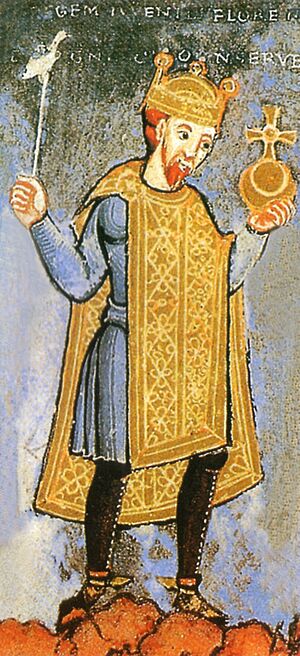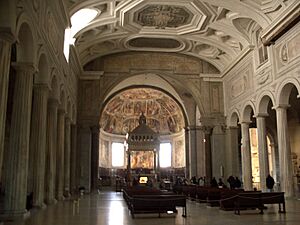History of the papacy (1048–1257) facts for kids

The history of the papacy (the office of the Pope) between 1046 and 1216 was a time of big disagreements. Popes and the Holy Roman Emperor often argued about who had more power. One major fight was called the Investiture Controversy. This was a dispute over whether the Pope or the Emperor could choose important church leaders, like bishops, in the Empire.
A famous event happened in 1077 when Emperor Henry IV walked to Canossa to meet Pope Gregory VII. This showed how much power the Pope had gained. Later, in 1122, the Emperor agreed in the Concordat of Worms that he would not choose bishops. But the arguments between popes and emperors continued.
During this time, the Holy Roman Empire was mostly ruled by German emperors. Parts of northern and central Italy became part of this Empire. This led to conflicts, and Italian cities often split into two groups: the Guelphs and Ghibellines. These groups supported either the Pope or the Emperor.
Big differences also grew between the Western (Catholic) and Eastern (Orthodox) parts of Christianity. This led to the East-West Schism, a major split in the Church. Even though leaders from both sides had met in earlier councils, their beliefs, languages, and political views drifted apart. This finally caused them to separate.
Later, Pope Urban II called for the Crusades in 1095. His speech at the Council of Clermont encouraged Christians to fight to take back the Holy Land.
Unlike earlier times, the way a new Pope was chosen became more organized during this period. In 1059, Pope Nicholas II created rules called In Nomine Domini. These rules said that only the College of Cardinals could vote for a new Pope. These new rules helped create the system for choosing a Pope that we still see today, called the papal conclave. A key person behind these changes was Cardinal Hildebrand, who later became Pope Gregory VII.
History of the Papacy
Choosing a New Pope
Pope Nicholas II, who became Pope in 1058, started many changes. These changes showed the growing tension between the Emperor and the Pope. In 1059, Pope Nicholas held a meeting in Rome. He spoke out against several wrong practices in the Church.
One big problem was simony, which meant buying or selling church jobs. He also spoke against priests getting married. Most importantly, he condemned unfair ways of choosing popes. Nicholas then made a rule that only a group of cardinals could choose the new Pope. This stopped kings and emperors from directly influencing who became Pope. In 1061, German bishops, who supported the Emperor, said all of Nicholas's new rules were invalid.
In 1059, Pope Nicholas II also made a new kind of agreement. He gave land to certain people, even if others already lived there. These people then had to promise loyalty to the Pope, like a knight to a lord. The Pope gave land in southern Italy and Sicily to the Normans. In return, the Normans promised to serve Rome.
These disagreements between emperors and popes continued for many years. They eventually led to a clearer separation between the Church and the government. In 1122, the Emperor signed the Concordat of Worms. He gave up his right to give bishops their symbols of spiritual power. Even though the Pope seemed to win this battle, emperors still tried to influence the papacy. And popes still wanted to have political power.
During the time of Pope Gregory VII, the title "Pope" officially meant only the Bishop of Rome. Gregory VII also greatly increased the Pope's power in worldly matters. He was a major reforming Pope. Gregory is most famous for his role in the Investiture Controversy. This was his big fight against Emperor Henry IV. He also led the Gregorian Reform movement, which aimed to make the Church stronger and more independent.
The Great Church Split
The East-West Schism was the event that divided Christianity into two main branches: Western Catholicism and Eastern Orthodoxy. While it is usually said to have happened in 1054, this split was actually the result of a long period of growing apart.
The main reasons for the Schism were disagreements over the Pope's authority. The Pope claimed he had authority over the four Eastern Greek-speaking patriarchs. The Eastern Church believed the Pope of Rome had a special honor and could hear appeals, but he did not have direct power over all other churches. They also disagreed about the Western Church adding the "filioque clause" to the Nicene Creed. This clause changed a part of the Christian belief statement.
There were also smaller reasons for the split. These included differences in church services and arguments over who had control in certain areas. The Church split along lines of belief, language, politics, and geography. This major break has never fully healed. There were attempts to reunite the two churches in 1274 and 1439. However, the Eastern Orthodox Church rejected these attempts. They felt their leaders had gone too far in agreeing to these "unions." Other efforts to bring the two sides together have also failed.
In the early 1090s, the Byzantine Emperor Alexius Comnenus asked Pope Urban II for help against the Turks. Pope Urban II saw this as a big chance. He thought it could help Christians take back control of the Holy Land. It could also unite European nobles by giving them a common enemy instead of fighting each other. Plus, helping the Byzantine Empire might bring the Eastern and Western Churches back together after almost 40 years of separation. This would make the Western Church and the papacy stronger.
On November 27, 1095, Pope Urban II gave a very important speech at the Council of Clermont. He combined the idea of going on a pilgrimage to the Holy Land with fighting a holy war. The Pope called for a "War of the Cross," or Crusade. He wanted to take back the holy lands from non-believers. Pope Urban II told the French people to use their swords for God's service. The crowd replied, "Dieu le veult!" which means "God wills it!"


